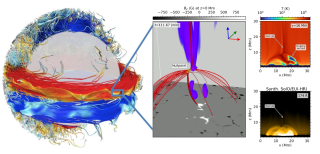Bibcode
Sen, Samrat; Prasad, Avijeet; Liakh, Valeriia; Keppens, Rony
Bibliographical reference
Astronomy and Astrophysics
Advertised on:
8
2024
Journal
Citations
1
Refereed citations
1
Description
Context. Erupting magnetic flux ropes play an important role in producing solar flares, whereas fine-scale condensed coronal rain is often found in post-flare loops. However, the formation of the MFRs in the pre-flare stage and how this leads to coronal rain in a post-eruption magnetic loop is not fully understood.
Aims: We explore the formation and eruption of MFRs, followed by the appearance of coronal rain in the post-flare loops to understand the magnetic and thermodynamic properties of eruptive events and their multi-thermal aspects in the solar atmosphere.
Methods: We performed a resistive-magnetohydrodynamic simulation with the open-source code MPI-AMRVAC to explore the evolution of sheared magnetic arcades that can lead to flux rope eruptions. The system was in mechanical imbalance at the initial state and evolved self-consistently in a nonadiabatic atmosphere under the influence of radiative losses, thermal conduction, and background heating. We used an additional level of adaptive mesh refinement to achieve the smallest cell size of ≈32.7 km in each direction to reveal the fine structures in the system.
Results: The system achieves a semi-equilibrium state after a short transient evolution from its initial mechanically imbalanced condition. A series of erupting MFRs is formed due to spontaneous magnetic reconnection across current sheets that are created underneath the erupting flux ropes. A gradual development of thermal imbalance is noted at a loop top in the post-eruption phase, which leads to catastrophic cooling and to the formation of condensations. We obtain plasma blobs that fall down along the magnetic loop in the form of coronal rain. The dynamical and thermodynamic properties of these cool condensations agree well with observations of post-flare coronal rain.
Conclusions: Our simulation supports the development and eruption of multiple MFRs and the formation of coronal rain in post-flare loops. This is one of the key aspects required to reveal the mystery of coronal heating in the solar atmosphere.
Aims: We explore the formation and eruption of MFRs, followed by the appearance of coronal rain in the post-flare loops to understand the magnetic and thermodynamic properties of eruptive events and their multi-thermal aspects in the solar atmosphere.
Methods: We performed a resistive-magnetohydrodynamic simulation with the open-source code MPI-AMRVAC to explore the evolution of sheared magnetic arcades that can lead to flux rope eruptions. The system was in mechanical imbalance at the initial state and evolved self-consistently in a nonadiabatic atmosphere under the influence of radiative losses, thermal conduction, and background heating. We used an additional level of adaptive mesh refinement to achieve the smallest cell size of ≈32.7 km in each direction to reveal the fine structures in the system.
Results: The system achieves a semi-equilibrium state after a short transient evolution from its initial mechanically imbalanced condition. A series of erupting MFRs is formed due to spontaneous magnetic reconnection across current sheets that are created underneath the erupting flux ropes. A gradual development of thermal imbalance is noted at a loop top in the post-eruption phase, which leads to catastrophic cooling and to the formation of condensations. We obtain plasma blobs that fall down along the magnetic loop in the form of coronal rain. The dynamical and thermodynamic properties of these cool condensations agree well with observations of post-flare coronal rain.
Conclusions: Our simulation supports the development and eruption of multiple MFRs and the formation of coronal rain in post-flare loops. This is one of the key aspects required to reveal the mystery of coronal heating in the solar atmosphere.
Movie associated to Fig. 3 is available at https://www.aanda.org.
Related projects

The Whole Sun Project: Untangling the complex physical mechanisms behind our eruptive star and its twins
The Sun is a magnetically active star with violent eruptions that can hit Earth´s magnetosphere and cause important perturbations in our technology-dependent society. The objective of the Whole Sun project is to tackle in a coherent way for the first time key questions in Solar Physics that involve as a whole the solar interior and the atmosphere
Fernando
Moreno Insertis

Numerical Simulation of Astrophysical Processes
Numerical simulation through complex computer codes has been a fundamental tool in physics and technology research for decades. The rapid growth of computing capabilities, coupled with significant advances in numerical mathematics, has made this branch of research accessible to medium-sized research centers, bridging the gap between theoretical and
Daniel Elías
Nóbrega Siverio